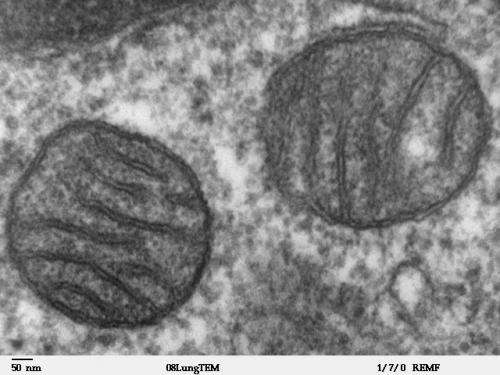Unearthing the secrets of cellular energy

Everything the body does—your brain thinking, your heart beating, your cells growing—requires energy. Consequently, it comes as no surprise that disruptions in energy production can contribute to a wide range of diseases. To address this common denominator, a team of scientists at the Gladstone Institutes and UC San Francisco (UCSF) led by Ken Nakamura, MD, Ph.D., turned to the molecular power-plants that produce a cell's energy, called mitochondria.
Mitochondria transform the energy (sugar, fat) in your diet into molecules called ATP (adensosine triphosphate). Cells then use energy-carrying ATP molecules to fuel their functions.
In a new study, published in PLOS Biology, the researchers used innovative technologies to generate the first large-scale list of genes that control the production of cellular energy stored in ATP molecules. Their findings provide a better understanding of the pathways that are critical for making cellular energy, and could lead to the identification of new drug targets.
When cells cannot maintain adequate levels of ATP, energy failure can cause or contribute to diseases, including mitochondrial disorders, heart disease, stroke, and neurodegenerative diseases. The organs that need energy the most—the brain, the heart, and the muscles—are particularly vulnerable to energy failure, which may develop gradually over decades, for example, in neurodegenerative disorders such as Alzheimer's disease and Parkinson's disease.
"Despite the importance of ATP for our cells to function, we understand very little about how the levels of this molecule are regulated and which genes are involved in that process," said Nakamura, investigator at Gladstone and senior author of the new study. "So, very few therapies exist to address common energy problems in cells."
Until now, scientists lacked the research tools needed to characterize energy-regulating genes. In the new study, Nakamura and his team combined two innovative techniques for the first time to identify genes that could influence the level of ATP within a single cell.
First, the researchers used a CRISPR genome targeting technique to turn off genes, suppressing one gene at a time in each cell. Next, they sorted the cells with a screening tool that detects ATP levels. In this way, they discovered which genes can increase or decrease ATP levels in the cell.
After testing more than 2,200 genes, they narrowed down the list to 156 genes that affected ATP levels most potently.
"We found that some genes are especially critical for cells to maintain healthy ATP levels," said the study's first author Bryce A. Mendelsohn, MD, Ph.D., an assistant professor of pediatrics at UCSF who specializes in gene mutations that cause metabolic diseases. "Such critical nodes had been suspected but never proven on a broad scale. We also identified some genes that were never before thought to be important for making energy. Our findings may also pave the way toward new approaches in personalized or precision medicine."
Coenzyme Q10 (CoQ10) is naturally present in cells and helps mitochondria produce energy. It is also one of the few drugs available to treat patients with mitochondrial diseases. However, this therapy is effective in only a small subset of patients, so the researchers sought to identify which mutations were most responsive to the drug.
Nakamura and colleagues demonstrated which ATP-regulating genes are affected by CoQ10 and believe their approach may allow them to figure out which patients might be most responsive to this or other energy-related therapies.
Modulating ATP levels is also a promising therapeutic avenue to treat cancer, because certain cancer cells have too much energy, which allows them to grow in an uncontrolled manner. In the study, the scientists showed that turning off a particular energy-modulating gene could stop the growth of tumor cells.
"The screening approach we developed has considerable potential for clinical translation," said Nakamura, who is also an associate professor of neurology at UCSF. "It will help us elucidate the roles of abnormal energy metabolism in diverse diseases and may ultimately help us design new strategies to treat these challenging conditions."
More information: Bryce A. Mendelsohn et al. A high-throughput screen of real-time ATP levels in individual cells reveals mechanisms of energy failure, PLOS Biology (2018). DOI: 10.1371/journal.pbio.2004624
Journal information: PLoS Biology
Provided by Gladstone Institutes




















